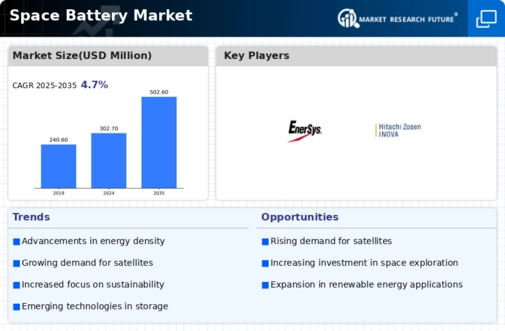North America : Innovation Hub for Space Batteries
North America dominates the Space Battery Market, holding a significant share of 150.0M in 2025. The region's growth is driven by robust investments in space exploration and satellite technology, alongside increasing demand for advanced energy storage solutions. Regulatory support from agencies like NASA and the FAA fosters innovation, ensuring compliance with safety and performance standards. The focus on sustainable energy solutions further propels market expansion, making North America a key player in the global landscape.
The competitive landscape in North America is characterized by the presence of major players such as NASA, Northrop Grumman, and Lockheed Martin. These companies are at the forefront of developing cutting-edge battery technologies tailored for space applications. The U.S. government’s commitment to space missions and partnerships with private firms enhances the region's market position. As a result, North America is expected to maintain its leadership in the Space Battery Market through 2025 and beyond.
Europe : Emerging Powerhouse in Space Tech
Europe is rapidly emerging as a significant player in the Space Battery Market, with a market size of 80.0M in 2025. The region benefits from strong governmental support and collaborative initiatives among EU member states, which drive innovation in space technologies. Regulatory frameworks, such as the European Space Agency's guidelines, promote sustainable practices and advanced battery technologies, enhancing market growth. The increasing focus on satellite deployment and space exploration fuels demand for efficient energy storage solutions.
Leading countries in Europe, such as France and Germany, are home to key players like Airbus and Thales, which are pivotal in advancing space battery technologies. The competitive landscape is marked by strategic partnerships and investments in R&D, aimed at enhancing battery performance and reliability. As Europe continues to strengthen its position in the space sector, the Space Battery Market is poised for substantial growth, supported by a collaborative ecosystem and innovative advancements.
Asia-Pacific : Emerging Market with Growth Potential
The Asia-Pacific region is witnessing a burgeoning Space Battery Market, projected to reach 60.0M by 2025. This growth is driven by increasing investments in space exploration and satellite technology, particularly in countries like Japan and China. Government initiatives aimed at enhancing space capabilities and fostering technological advancements are key growth drivers. Regulatory support for sustainable energy solutions further catalyzes market expansion, as the region seeks to establish itself as a leader in space technology.
Japan stands out as a leading country in the region, with companies like Mitsubishi Electric playing a crucial role in developing innovative battery solutions for space applications. The competitive landscape is evolving, with emerging players and collaborations enhancing technological capabilities. As the Asia-Pacific region continues to invest in space initiatives, the demand for advanced battery technologies is expected to rise, positioning it as a significant player in the global market.
Middle East and Africa : Resource-Rich Frontier for Innovation
The Middle East and Africa region is gradually establishing its presence in the Space Battery Market, with a market size of 12.67M in 2025. The growth is primarily driven by increasing investments in space programs and satellite technologies, particularly in countries like the UAE and South Africa. Government initiatives aimed at enhancing technological capabilities and fostering international collaborations are pivotal in driving market development. Regulatory frameworks are evolving to support sustainable practices in energy storage solutions, further boosting market potential.
Countries like the UAE are making significant strides in space exploration, with initiatives such as the Mars Mission. The competitive landscape is characterized by emerging players and partnerships with established firms, enhancing the region's technological capabilities. As the Middle East and Africa continue to invest in space technologies, the demand for innovative battery solutions is expected to grow, positioning the region as a future player in The Space Battery.

















Leave a Comment